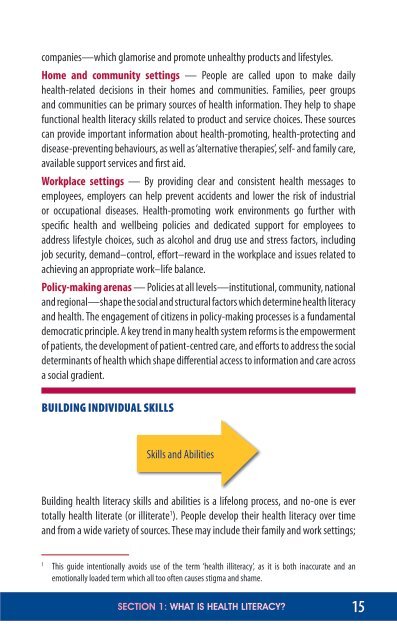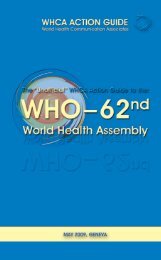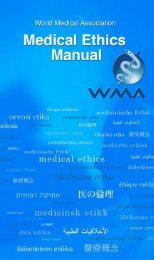the basics - World Health Communication Associates
the basics - World Health Communication Associates
the basics - World Health Communication Associates
- No tags were found...
Create successful ePaper yourself
Turn your PDF publications into a flip-book with our unique Google optimized e-Paper software.
companies—which glamorise and promote unhealthy products and lifestyles.Home and community settings — People are called upon to make dailyhealth-related decisions in <strong>the</strong>ir homes and communities. Families, peer groupsand communities can be primary sources of health information. They help to shapefunctional health literacy skills related to product and service choices. These sourcescan provide important information about health-promoting, health-protecting anddisease-preventing behaviours, as well as ‘alternative <strong>the</strong>rapies’, self- and family care,available support services and first aid.Workplace settings — By providing clear and consistent health messages toemployees, employers can help prevent accidents and lower <strong>the</strong> risk of industrialor occupational diseases. <strong>Health</strong>-promoting work environments go fur<strong>the</strong>r withspecific health and wellbeing policies and dedicated support for employees toaddress lifestyle choices, such as alcohol and drug use and stress factors, includingjob security, demand–control, effort–reward in <strong>the</strong> workplace and issues related toachieving an appropriate work–life balance.Policy-making arenas — Policies at all levels—institutional, community, nationaland regional—shape <strong>the</strong> social and structural factors which determine health literacyand health. The engagement of citizens in policy-making processes is a fundamentaldemocratic principle. A key trend in many health system reforms is <strong>the</strong> empowermentof patients, <strong>the</strong> development of patient-centred care, and efforts to address <strong>the</strong> socialdeterminants of health which shape differential access to information and care acrossa social gradient.BUILDING INDIVIDUAL SKILLSSkills and AbilitiesBuilding health literacy skills and abilities is a lifelong process, and no-one is evertotally health literate (or illiterate 1 ). People develop <strong>the</strong>ir health literacy over timeand from a wide variety of sources. These may include <strong>the</strong>ir family and work settings;1This guide intentionally avoids use of <strong>the</strong> term ‘health illiteracy’, as it is both inaccurate and anemotionally loaded term which all too often causes stigma and shame.SECTION 1: WHAT IS HEALTH LITERACY? 15






